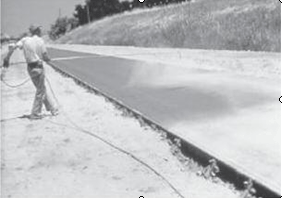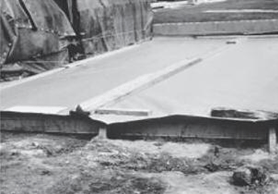Information from the National Ready Mixed Concrete Association
WHAT is Curing?

Application of liquid membrane-forming compound with a hand sprayer
Curing is the maintaining of an adequate moisture content and temperature in concrete at early ages so that it can develop properties the mixture was designed to achieve. Curing begins immediately after placement and finishing so that the concrete may develop the desired strength and durability.
Without an adequate supply of moisture, the cementitious materials in concrete cannot react to form a quality product. Drying may remove the water needed for this chemical reaction called hydration and the concrete will not achieve its potential properties.
Temperature is an important factor in proper curing, since the rate of hydration, and therefore, strength development, is faster at higher temperatures. Generally, concrete temperature should be maintained above 50°F (10°C) for an adequate rate of strength development. Further, a uniform temperature should be maintained through the concrete section while it is gaining strength to avoid thermal cracking.
For exposed concrete, relative humidity and wind conditions are also important; they contribute to the rate of moisture loss from the concrete and could result in cracking, poor surface quality and durability. Protective measures to control evaporation of moisture from concrete surfaces before it sets are essential to prevent plastic shrinkage cracking.

Slab on grade covered with waterproof paper for curing
WHY Cure?
Several important reasons are:
- Predictable strength gain: Laboratory tests show that concrete in a dry environment can lose as much as 50 percent of its potential strength compared to similar concrete that is moist cured. Concrete placed under high temperature conditions will gain early strength quickly but later strengths may be reduced. Concrete placed in cold weather will take longer to gain strength, delaying form removal and subsequent construction.
- Improved durability: Well-cured concrete has better surface hardness and will better withstand surface wear and abrasion. Curing also makes concrete more watertight, which prevents moisture and water-borne chemicals from entering into the concrete, thereby increasing durability and service life.
- Better serviceability and appearance: A concrete slab that has been allowed to dry out too early will have a soft surface with poor resistance to wear and abrasion. Proper curing reduces crazing, dusting and scaling.
HOW to Cure
Moisture Requirements for Curing: Concrete should be protected from losing moisture until final finishing using suitable methods like wind breaks, fogger sprays or misters to avoid plastic shrinkage cracking. After final finishing, the concrete surface must be kept continuously wet or sealed to prevent evaporation for a period of at least several days after finishing. See the table for examples.
Systems to keep concrete wet include:
- Burlap or cotton mats and rugs used with a soaker hose or sprinkler. Care must be taken not to let the coverings dry out and absorb water from the concrete. The edges should be lapped and the materials weighted down so they are not blown away.
- Straw that is sprinkled with water regularly. Straw can easily blow away and, if it dries, can catch fire. The layer of straw should be 6 inches thick, and should be covered with a tarp.
- Damp earth, sand, or sawdust can be used to cure flatwork, especially floors. There should be no organic or iron-staining contaminants in the materials used.
- Sprinkling on a continuous basis is suitable provided the air temperature is well above freezing. The concrete should not be allowed to dry out between soakings, since alternate wetting and drying is not an acceptable curing practice. Ponding of water on a slab is an excellent method of curing. The water should not be more than 20°F (11 °C) cooler than the concrete and the dike around the pond must be secure against leaks.
Control Temperature:
In cold weather, do not allow concrete to cool faster than a rate of 5°F (3°C) per hour for the first 24 hours. Concrete should be protected from freezing until it reaches a compressive strength of at least 500 psi (3.5 MPa) using insulating materials. Curing methods that retain moisture, rather than wet curing, should be used when freezing temperatures are anticipated. Guard against rapid temperature changes after removing protective measures.
In hot weather, higher initial curing temperature will result in rapid strength gain and lower ultimate strengths. Water curing and sprinkling can be used to achieve lower curing temperatures in summer. Day and night temperature extremes that allow cooling faster than 5°F (3°C) per hour during the first 24 hours should be protected against.
Moisture-retaining materials include:
- Plastic sheets— either clear, white (reflective) or pigmented. Plastic should conform to ASTM C 171, be at least 4 mils thick, and preferably reinforced with glass fibers. Dark-colored sheets are recommended when ambient temperatures are below 60°F (15°C) and reflective sheets should be used when temperatures exceed 85°F (30°C). The plastic should be laid in direct contact with the concrete surface as soon as possible without marring the surface. The edges of the sheets should overlap and be fastened with waterproof tape and then weighted down to prevent the wind from getting under the plastic. Plastic can make dark streaks wherever a wrinkle touches the concrete, so plastic should not be used on concretes where appearance is important. Plastic is sometimes used over wet burlap to retain moisture.
- Waterproof paper— used like plastic sheeting, but does not mar the surface. This paper generally consists of two layers of kraft paper cemented together and reinforced with fiber. The paper should conform to ASTM C 171.
Note that products sold as evaporation retardants are used to reduce the rate of evaporation from fresh concrete surfaces before it sets to prevent plastic shrinkage cracking. These materials should not be used for final curing.
References
- Effect of Curing Condition on Compressive Strength of Concrete Test Specimens, NRMCA Publication No. 53, National Ready Mixed Concrete Association, Silver Spring, MD.
- How to Eliminate Scaling, Concrete International, February 1980. American Concrete Institute, Farmington Hills, MI.
- ASTM C 309, Specification for Liquid Membrane-Forming Compounds for Curing Concrete, American Society for Testing Materials, West Conshohocken, PA.
- ASTM C 171, Specification for Sheet Materials for Curing Concrete, American Society for Testing Materials, West Conshohocken, PA.
- Cold Weather Concreting, ACI 306R, American Concrete Institute, Farmington Hills, MI
USED WITH PERMISSION FROM THE NRMCA
